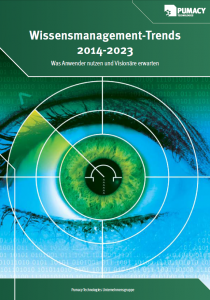
A brief knowledge management lexicon
The gathering of experiences and information, the dissemination of your own knowledge and that of others, and thus the augmentation of our overall stock of knowledge have been part of human culture for millennia.
Accordingly, countless methods and practices have developed to shape the way we deal with knowledge, insights and information. Only in the past few decades – with the emphasis on applications in the industrial society – has the way in which knowledge is systematically recorded, disseminated and brought to bear been examined more closely.
GAt the same time, a multitude of terms have come into use, that in some cases describe completely new approaches, but sometimes only place existing methods in the knowledge management context.
 In this respect, we recommend the following study: Knowledge Management Trends 2014-2023: What Users Utilize and Visionaries Expect. This trends study by Pumacy Technologies AG provides a response to which knowledge management approaches will meet with success in practical use in the coming years.
In this respect, we recommend the following study: Knowledge Management Trends 2014-2023: What Users Utilize and Visionaries Expect. This trends study by Pumacy Technologies AG provides a response to which knowledge management approaches will meet with success in practical use in the coming years. Knowledge management definitions
- Knoweldge: in philosophy frequently defined as a justified, true belief. In practice, however, the real question is what distinguishes knowledge from already existing (and comparatively easy to manage) information or data: knowledge, then, relates above all to the personal experiences of the people involved, to the purpose or context of individual pieces of information (i.e. to the snippets of information that are important in the respective situation) or to the “why” that lies behind decisions, processes and organizational structures.
- Implicit knowledge: knowledge that has not been put into writing, but instead exists unspoken in the heads of the people concerned, in processes or other organizational structures. The putting into writing or dissemination of implicit knowledge is – although desirable in principle – associated with a loss of knowledge..
- Explicit knowledge: knowledge that has been documented in writing, e.g. in the form of publications, rules, case studies or instructions. Making knowledge explicit is a prerequisite for saving or communicating knowledge using IT systems.
- Knowledge management: describes the totality of activities that ensure the identification, distribution, development, use and securing of the relevant knowledge – in brief: the planned, systematic handling of knowledge, be it in a company, a public institution or the private sphere.
- Knowledge objectives: specify which skills should be developed and on which level (normative, strategic, operational)
- Knowledge identification: contains the analysis and description of the knowledge environment, i.e. overview of internal and external data, information and skills
- Knowledge acquisition: describes the exploiting of the potential of different knowledge sources (e.g. experts, cooperations, partners, suppliers, customers etc.)
- Knowledge development: describes the management efforts to develop and build up skills that do not yet exist in the company
- Knowledge dissemination: describes the sensible dissemination of existing knowledge within a company
- Knowledge utilization: ensures the productive use of organizational knowledge
- Knowledge retention: includes the systematic retention of experiences, skills and information
- Knowledge evaluation: includes methods for measuring normative, strategic and operational knowledge objectives
- Collective knowledge: describes the efficient combining of different aspects of knowledge and knowledge carriers for collective problem solving and is thus greater than the sum of individual knowledge
- Organizational knowledge bases: are individual and collective inventories of knowledge and information for the ability to solve problems and work autonomously
- Organizational learning: describes changing the organizational knowledge base and increasing the organizational ability to solve problems and work autonomously
- Expert directory: the problem-solving expertise and ability of individual employees is described and matched to a list of typical problems (like the “Yellow Pages”); simplifies the access to internal expertise
- Knowledge maps: are graphical depictions of knowledge areas, e.g. knowledge carriers, knowledge inventories, sources of knowledge or knowledge structures in an organization. Instead of an actual map, mind maps or similar network diagrams are often used
- Lessons learned: are project experiences or case studies that are described and interpreted in order to help teams in future projects
- Best practices: include successful methods gleaned from previous experiences (similar to a systematic instruction or a recipe for recurrent problems)
- Workflow: describes what is generally an IT-supported sequence of activities and includes all roles, tasks, interrelations, conditions, times and environments involved in coordination.
- Cloud computing: is a model that makes available computer resources (e.g. networks, storage systems, applications and services), which previously were run on a local computer, on the internet or intranet via technical interfaces and thus makes them accessible at all times and from anywhere.
- Software as a Service (SaaS): is a software provider sales model in which software – including maintenance and administration – is made available on the internet; the customer pays for using it on the internet, without having to install the software locally.
Test KMcloud now!
Share your experiences with us!
We look forward to receiving your wide-ranging feedback. Over the course of this year, KMcloud will be fully adapted to meet your wishes and needs.
